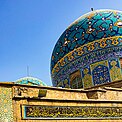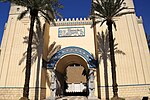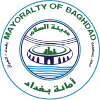Baghdad
بَغْدَاد | |
|---|---|
| Mayoralty of Baghdad | |
Top-bottom, L-R: Aerial view of the Green Zone; Haydar-Khana Mosque • Statue of Karim Qasim Iraq Museum • House of Sassoon Eskell Atraqchi for Art & cultural heritage • View over Baghdad and the Tigris river | |
| Nickname: City of Peace (مَدِيْنَةُ السَّلَام)[1] | |
| Coordinates: 33°18′55″N 44°21′58″E / 33.31528°N 44.36611°E | |
| Country | Iraq |
| Governorate | Baghdad |
| Established | 30 July 762 AD |
| Founded by | Caliph al-Mansur |
| Districts | 11 |
| Government | |
| • Type | Mayor–council |
| • Body | Baghdad City Advisory Council |
| • Mayor | Ammar Moussa Kadhum |
| Area | |
| • Total | 673 km2 (260 sq mi) |
| Elevation | 34 m (112 ft) |
| Population | |
| • Estimate (2024) | 7,921,134[2] |
| • Rank | 1st in Iraq |
| • Density | 12,000/km2 (30,000/sq mi) |
| Demonym | Baghdadi |
| Time zone | UTC+03:00 (Arabian Standard Time) |
| • Summer (DST) | (Not Observed) |
| Postal code | 10001 to 10090 |
| Website | amanatbaghdad.gov.iq (in Arabic) |
Baghdad[note 1] is the capital and largest city of Iraq. Situated on the Tigris, it is part of the Baghdad Governorate and is located near the Diyala River. With a population variously estimated at 6 or over 7 million, Baghdad forms 22% of Iraq's total population. In comparison to its large population, the city has a small area at just 673 square kilometers (260 sq mi). It is the second-largest city in the Arab world after Cairo, and the second-largest city in West Asia after Tehran. Baghdad is historically known as a global cultural hub.[note 2]
In 762 AD, Baghdad was founded as the capital of the Abbasid Caliphate, and became its most notable major development project. Within a short time, it evolved into a significant cultural and intellectual center of the Muslim world. This, in addition to housing several key academic institutions, including the House of Wisdom, as well as a multi-ethnic and multi-religious environment, garnered it a worldwide reputation as the "Center of Learning". For much of the Abbasid era, during the Islamic Golden Age, Baghdad was the largest city in the world. Its population peaked at more than one million people. The city was largely destroyed at the hands of the Mongol Empire in 1258, resulting in a decline that would linger through many centuries due to frequent plagues and multiple successive empires, such as the Mesopotamian Mamluk Sultanate and the Ottoman Empire, until the World War I.[7]
The city served as capital of the former British Mandate of Mesopotamia. With the recognition of Iraq as an independent monarchical state in 1932, Baghdad gradually regained some of its former prominence as a significant center of Arab culture. Baghdad has faced severe infrastructural damage due to the Iraq War, which began with the United States-led invasion of Iraq, the subsequent insurgency and renewed war, resulting in a substantial loss of cultural heritage and historical artifacts. During this period, it had one of the highest rates of terrorist attacks in the world. However, terrorist attacks have gradually been on the decline since the territorial defeat of the Islamic State militant group in Iraq in 2017, and are very rare now.[8]
A major center of Islamic history, the city is known for its numerous historic mosques. It includes museums such as the Iraq Museum, Baghdadi Museum and Abd al-Karim Qasim Museum. Baghdad is also nicknamed as "City of Palaces", as its home to numerous palaces such as Abbasid Palace, Radwaniyah Palace and Al-Faw Palace. Previously being multi-religious city, the city is also many churches, mandis and synagogues. Through its airport, Baghdad is known as the "Gateway of Iraq".
- ^ Petersen, Andrew (13 September 2011). "Baghdad (Madinat al-Salam)". Islamic Arts & Architecture. Archived from the original on 16 September 2016. Retrieved 23 August 2016.
- ^ "Baghdad Population Live". Retrieved 16 May 2024.
- ^ "Iraq". The World Factbook (2024 ed.). Central Intelligence Agency. Retrieved 16 May 2020. (Archived 2020 edition.)
- ^ "Baghdad" Archived 9 October 2015 at the Wayback Machine. Encyclopædia Britannica. Encyclopædia Britannica Online. 19 July 2019.
- ^ Gilbert Burnham; Riyadh Lafta; Shannon Doocy; Les Roberts (11 October 2006). "Mortality after the 2003 invasion of Iraq: a cross-sectional cluster sample survey". The Lancet. 368 (9545): 1421–1428. CiteSeerX 10.1.1.88.4036. doi:10.1016/S0140-6736(06)69491-9. ISSN 0140-6736. PMID 17055943. S2CID 23673934. Archived from the original on 14 May 2013. Retrieved 14 June 2013. (110 KB)
- ^ "Cities and urban areas in Iraq with population over 100,000" Archived 15 November 2006 at the Wayback Machine, Mongabay.com
- ^ "Largest Cities Through History". Geography.about.com. 6 April 2011. Archived from the original on 27 May 2005. Retrieved 19 June 2011.
- ^ "Twin Suicide Bombings In Baghdad Market Kill At Least 32, Wound Over 100". National Public Radio. Archived from the original on 21 May 2021. Retrieved 23 May 2021.
Cite error: There are <ref group=note> tags on this page, but the references will not show without a {{reflist|group=note}} template (see the help page).











